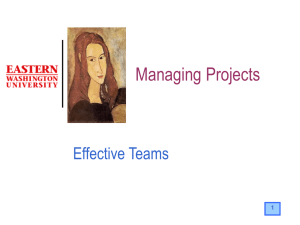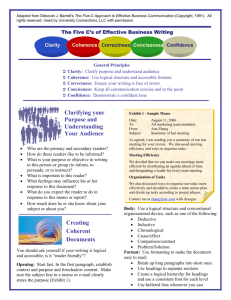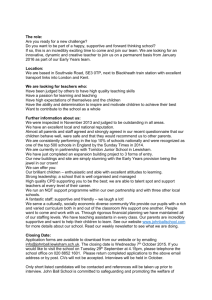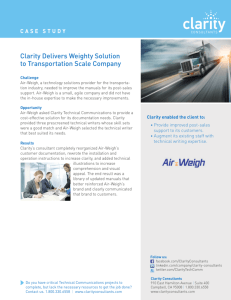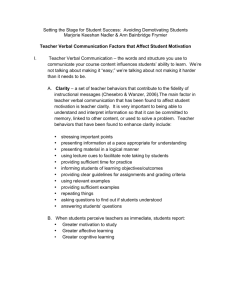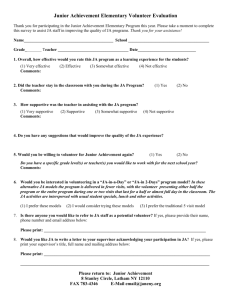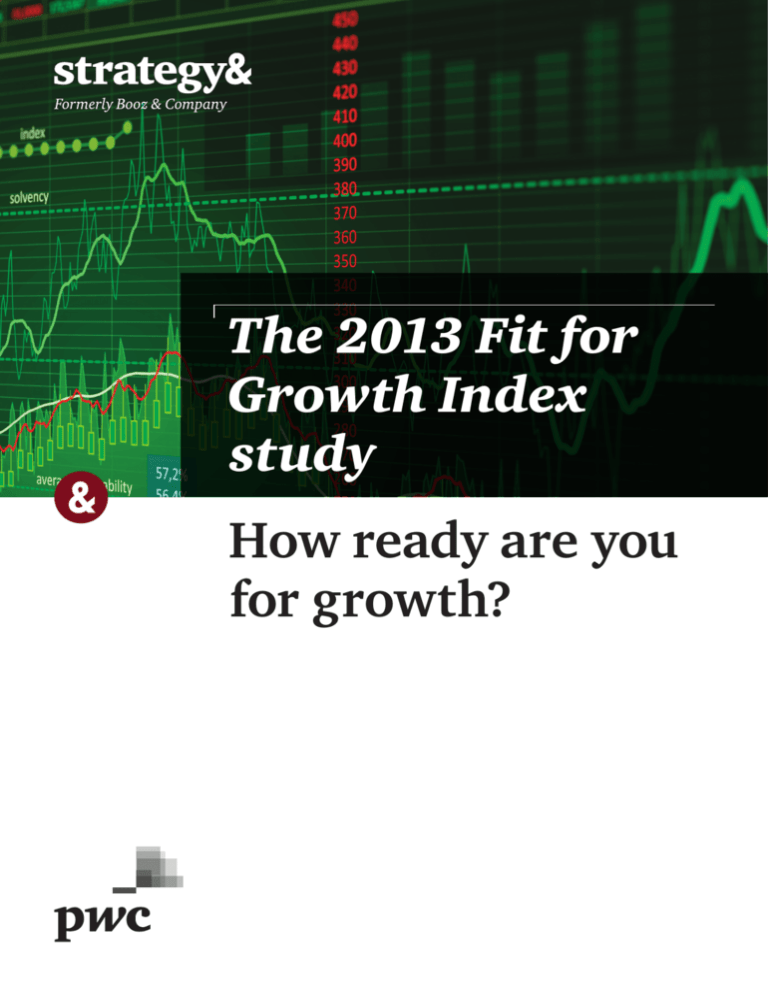
The 2013 Fit for
Growth Index
study
How ready are you
for growth?
Contact
North America
Siobhan Ford
Director, Marketing
+1-212-551-6234
siobhan.ford
@strategyand.pwc.com
This report was originally published by Booz & Company in 2013.
For further information: Fit for Growth microsite page (www.strategyand.pwc.com/global/home/what-we-think/
fitforgrowth)
2
Strategy&
Executive summary
Since the 2008 economic crisis, many companies have been trying
to figure out the best way to reposition themselves for growth and
economic recovery. At Strategy&, working with many leading
businesses across a variety of industries, we have gained deep insights
into what winning organizations do to return to sustainable high
performance. It’s a combination of three things:
First, they create clarity and coherence in their strategy — being clear
about how they’re adding value and articulating the differentiating
capabilities they need to win in the marketplace.
Second, they put in place an optimized cost structure and approach to
capital allocation — continuously investing in the capabilities critical to
success, while proactively cutting costs in less critical areas to fund
these investments.
Third, they build supportive organizations — redesigning structures,
incentives, decision rights, information flows, skill sets, and other
organizational and cultural elements so the collective actions of their
people align more closely with their strategy.
Such a Fit for Growth* approach builds competitive muscle while cutting
the corporate fat that weighs a company down. Companies that follow
this approach take proactive and strategic cost actions (as opposed to
reactive and tactical ones), freeing up funds to reinvest in those parts of
the business that are most important for growth. At the same time, they
put in place an organizational fabric that guides employees to do the
right things day in and day out, thus helping the entire enterprise build
and sustain competitive advantage.
Having seen these three elements create value in the market, Strategy&
decided to actually measure the benefits of this Fit for Growth approach.
* Fit for Growth is a registered service mark of PwC Strategy& Inc. in the United States.
Strategy&
3
In order to do so, we created a quantitative metric — the Fit for Growth
Index (“the index”) — that is built on these three elements, and
analyzed how it correlates with company performance.
Main findings of the study
As part of the study, we analyzed almost 200 public companies across a
wide range of industries, compiling their index score and determining
their total shareholder return over the past two years.
Here are the main findings from our study:
1)There is a clear correlation between the Fit for Growth Index score and
market performance. Companies that focus on the three elements
— strategic clarity and coherence, resource alignment, and
supportive organization — generate higher shareholder returns.
2)High-performing companies tightly link their growth and cost agendas.
They clearly understand which capabilities are truly critical for
winning with their strategy, and they funnel the bulk of their
resources to those differentiating capabilities.
3) Few companies are ready to grow. Although the three dimensions to focus
on may seem clear and the positive impact is obvious, less than one-fifth
of the companies (17 percent) seem well prepared to grow. Very few
companies — only 6 percent of those included in the study — perform
well along all three dimensions of the Fit for Growth Index.
4)Companies fall into a set of five “archetypes” with common
characteristics. Depending on where their strengths and weaknesses
lie, companies fall into one of five broad archetypes. Each of those
company archetypes has its own characteristics and challenges, and
we’ve identified a specific set of recommendations for each.
Implications for management
Few companies would disagree that robust strategies, solid cost
management, and powerful organizations are critical to performance.
But they may not be aware of how much these three elements need to
reinforce one another. Combining them is the hard part: Our research
shows that few companies are masters in integrating all three elements.
Making improvements requires a dispassionate clear-headedness about
one’s strengths and weaknesses, an understanding of where the links
between strategy, resource management, and organization are broken,
and the development of a clear plan of attack to reap the benefits.
4
Strategy&
Key highlights
• Strategy& has found that sustainable company performance is driven
by the extent to which companies are able to link their growth and
cost agendas.
• We developed the Fit for Growth* Index, a composite measurement of
a company’s “health” along three critical dimensions: strategic clarity
and coherence, resource alignment, and supportive organization.
• There is a clear correlation between high Fit for Growth Index scores
and market performance. Doing well on the three attributes of the
index matters.
• To maximize performance, companies need to be strong on all three
index dimensions — doing well on one or two dimensions only will
lead to suboptimal performance.
• Companies fall into five archetypes, each with its own unique
symptoms, challenges, and management priorities.
• Executives need to recognize their current archetype, understand
where they are weak, what they must change in order to become
ready for growth, and develop a credible road map to link their
growth and cost agendas.
* Fit for Growth is a registered service mark of PwC Strategy& Inc. in the United States.
Strategy&
5
Now that the global
recession has subsided, how do
we best position our company
for growth?
Should we continue to
push for cost cutting, or
should we release funds to
invest in growth?
How can we get our
initiatives and priorities to be
in line with our strategy?
What are our
highest-priority areas
to invest in?
6
How do we know whether
we’ve cut too much, whether
we’ve cut the muscle rather
than just the fat?
Is there still fat in our
organization … and where
shall we look for it?
Why can’t we seem
to make cost discipline
sustainable?
Strategy&
The Fit for Growth Index
The Fit for Growth Index measures how well a company connects its
cost and growth agendas. It assesses companies in three key areas:
strategic clarity and coherence, resource alignment and supportive
organization.
Fit for Growth framework
Strategy & way to play
Enable &
sustain
reductions
Release
funds
Strategic clarity
and coherence
• Clearly articulated and
coherent strategy
• Sustainable and
differentiating capabilities
for growth
• Presence in critical
product, market, and
customer segments
• Clear articulation of how the
business creates differentiated
value for customers
Resource alignment
Invest in
highervalueadded
priorities
• Lean cost structure in
low-criticality areas
• Proactive and tailored
cost reduction actions
• Systematic investments
in differentiating capabilities
Supportive
organization
• Organizational structure
that is market-back and
tied to the basic
characteristics of the
business
• Coherent and supportive
incentives, decision rights,
skill sets, culture
Key dimensions of Fit for Growth Index
Strategy&
7
A company’s Fit for Growth Index score is a weighted average of the
company’s fitness (on a scale from 1 to 5) along each of those three
dimensions.
We developed the Fit for Growth Index so we could:
• Determine how important the three elements — strategic clarity and
coherence, resource alignment, and supportive organization — are
for a company’s performance
• Assess which of those elements is most important in driving
performance
• Identify common characteristics among companies that would allow
us to formulate recommendations for how they can improve their
readiness for growth.
8
Strategy&
Companies with a high
Fit for Growth Index
perform better
To measure the connection to corporate performance, we determined
the Fit for Growth Index score for close to 200 companies and compared
it to the company’s total shareholder returns over the two-year period
from August 2010 to July 2012. We found a strong correlation between
companies’ shareholder returns and their Fit for Growth Index scores.
Correlation between Fit for Growth Index score and two-year normalized TSR score
n = 197
Normalized TSR score
Capital One Financial Corporation
100
Comcast Corporation
Limited Brands Inc.
90
Whole Foods Market Inc.
BlackRock Inc.
U.S. Bancorp
80
70
Diageo
60
50
Time Warner
Cable Inc.
Luxottica Group SpA
Wal-Mart Stores Inc.
40
30
20
10
0
1.0
1.5
2.0
2.5
3.0
3.5
Fit for Growth Index score
Strategy&
4.0
4.5
5.0
Source: Capital IQ
database; Strategy&
analysis
9
• 73 percent of companies with high index scores had high or
medium-high TSR scores, and companies scoring lower on the
index also had lower TSR scores.
• The strength of the relationship between index score and TSR score
varies by industry, but it is present in each of the 17 industry sectors
we have analyzed.
Percentage of companies in specific TSR score band by Fit for Growth Index score band
n = 197
High Fit for Growth
Index score
TSR score
64 companies
107 companies
19%
16%
34%
27%
45%
26 companies
42%
31%
47%
12%
Low & medium-low
(1 - 3)
Medium-high
(3.1 - 3.7)
Fit for Growth Index score band
10
Low (0 - 25)
Medium-low (25 - 50)
Medium-high (50 - 75)
High (75 - 100)
27%
High
(3.8 - 5)
Note: Width of bars
corresponds to number of
companies in each Fit for
Growth Index score band.
Source: Capital IQ
database; Strategy&
analysis
Strategy&
The most important
drivers of performance
Once we had established the link between index scores and market
returns, the next logical question became: What specific elements, if
any, in the index framework best explain strong performance?
Some of the factors within each of the three key building blocks —
strategic clarity and coherence, resource alignment, and supportive
organization — appear to have a particularly powerful impact on TSR
scores. These include:
Strategy&
11
Index building blocks and sub-factors
the particularly strong TSR impact
Starting questions for managers
Strategic clarity:
Coherent strategy
• Does the strategy represent a differentiated
way to play in the market?
• Is the strategy reflected in a clearly stated
list of firm-wide strategic priorities?
• Is the strategy aligned with the changes
in the market?
• Is the strategy well documented?
Resource alignment:
Systematic investments in differentiating
capabilities
• Is there an objective and disciplined
resource allocation process that focuses
on strengthening differentiating
capabilities?
Supportive organization:
Speed and decisiveness in response to
market or internal challenges
• Does the organizational structure enable
nimble governance?
• Are mechanisms in place to enable
cross-business unit collaboration?
• Is the organization efficient, flexible,
and lean?
12
Strategy&
Five company archetypes
When analyzing how companies performed along the three dimensions
of the Fit for Growth Index, we discovered a clear clustering of
companies into five archetypes: five types of companies, each with its
own set of characteristics. For each archetype, we developed
recommendations for improving readiness to grow.
Strategy&
13
Strategically adrift
“Strategically adrift” companies have:
– An unclear strategy and critical priorities that are not widely understood,
even among top management.
– A lack of clarity as to the capabilities that are essential for them to win in their markets.
– A reactive approach—their strategic decisions are easily swayed by external events,
and competitors’ actions can easily propel them in new directions.
Strategic Resource Supportive
clarity and alignment organization
coherence
Action: “Strategically adrift” companies should focus on identifying their differentiating
capabilities and develop a strategy that leverages those competitive advantages.
Distracted
“Distracted” companies have:
+ Moderate effectiveness and efficiency.
– Some critical capabilities present as “table stakes” for the industry, but they are not
distinctive enough to serve as a competitive advantage.
– A strategy that is not focused enough to mobilize investment.
Action: “Distracted” companies should sharpen their strategic focus and align the
company around those capabilities that give them a right to win.
Strategic Resource Supportive
clarity and alignment organization
coherence
Capability constrained
“Capability constrained” companies have:
+ A big-picture understanding of what it takes to win, but they need more discipline
in execution.
+ Terrific strategies, and a coherent and clearly articulated set of capabilities.
– Cost structures and approaches to investment management that aren’t keeping
pace with their intent.
– Strategies and capabilities systems that aren’t as effective as they could be; and
inadequate practices, processes, or technologies that often hold them back.
Strategic Resource Supportive
clarity and alignment organization
coherence
Action: “Capability constrained” companies should be very clear about what exact
capabilities they need and then work on processes, systems, skills, behaviors, and
organization—all together—to become world-class at what’s most important for them.
In the game
“In the game” companies have:
+ Strategic focus.
+ A diligent approach to capability building.
+ Good market effectiveness.
– Suboptimal organization, e.g., complicated matrix structures and onerous governance
processes that undermine speed and effectiveness.
Strategic Resource Supportive
clarity and alignment organization
coherence
Action: “In the game” companies should focus on internal structures and processes. They
need to realign their management structures, decision making, and talent to support
strategic priorities.
Ready for growth
“Ready for growth” companies are firing on all three cylinders. They have:
+ Well-developed strategic capabilities that also are well understood throughout
the organization.
+ Systematic ways to direct resources to initiatives with the highest strategic and
financial returns.
+ Organizational structures that support key capabilities, with talent in the right places
and efficient decision making.
Strategic Resource Supportive
clarity and alignment organization
coherence
14
The market success of “ready for growth” companies rests on a foundation of coherent,
proven, and sustainable capabilities, not transitory factors like managerial talent or favorable
market conditions.
Strategy&
• Among the 197 companies that we studied, only 17 percent were
classified as “in the game” or “ready for growth” and thus well
equipped for expansion.
Distribution of archetypes across sample companies
Strategically adrift
Distracted
14%
49%
Capability constrained
20%
In the game
11%
Ready for growth
6%
100%
Strategy&
Source: Strategy&
15
What a “ready for growth”
company looks like
Every company is different; however, our analysis revealed a set of
charac­te­r is­tics that are common to many of the companies in the
strongest (“ready for growth”) archetype. Consider these elements
across the three building blocks of the Fit for Growth framework:
• Strategic clarity and coherence — “ready for growth” companies …
–– Have specific and actionable strategic priorities that are widely
understood at all levels of the company
–– Make clear choices, striving for best-in-class status only in the few
distinctive capabilities that create sustainable competitive
advantage, and accept “good enough” in other areas
–– Are able to keep their strategies relevant by sensing and rapidly
adapting to market changes
–– Are quicker to innovate, willing to make calculated big bets
–– Feel no qualms about killing investments that aren’t paying off.
• Resource alignment — “ready for growth” companies …
–– Employ a disciplined process that ensures adequate funding for
high-growth, core activities
–– Have clear and objective investment criteria that prevent
department rivalries from interfering with allocation of funds to
top corporate priorities
–– Manage spending strategically, making rigorous trade-offs based
on cost transparency and a deep understanding of how they make
money.
16
Strategy&
• Supportive organization — “ready for growth” companies …
–– Are organizationally efficient, flexible, and lean
–– Align their power structures and allocate decision rights in ways
that best serve strategic priorities and business realities
–– Create nimble mechanisms for governance and collaboration
across business units
–– Have talent management practices that support key capabilities by
moving the best people into pivotal roles
–– Have a coherent culture that sets norms and expectations that
reflect the requirements for success in the marketplace
–– Have an ethos of excellence and continuous improvement that is
reinforced by meritocratic systems.
Strategy&
17
Coherent
strategy
Strategic
clarity and
coherence
Supportive
culture
Strong
leadership
in key roles
Strong
capabilities
“Ready for
growth”
company
Strong and
coherent product
portfolio
18
Decisiveness
with respect to
market & internal
challenges
Improvement
initiatives
aligned with
strategy
Presence in
critical markets
Systematic
investments in
differentiating
capabilities
Supportive
organization
Thoughtful
cost
reduction
Resource
alignment
Strategy&
Industry case study: Fit for
Growth Index in the consumer
packaged goods sector
We conducted a deep-dive on the consumer packaged goods (CPG)
industry to assess how the Fit for Growth Index impacts company
performance in a specific industry.
The Fit for Growth Index and consumer packaged goods
Financial performance (normalized TSR score)
100
Constellation Brands
Brown-Forman
Anheuser-Busch InBev
80
Church & Dwight
Kimberly-Clark
Mattel
Colgate-Palmolive
Whirlpool
60
Diageo
Newell Rubbermaid
Coca-Cola
ConAgra Foods
PepsiCo
Molson Coors Brewing
40
Clorox
J.M. Smucker
Tyson Foods
American Greetings
General Mills
Kellogg
Campbell Soup
20
Avon Products
0
1.0
1.5
2.0
2.5
3.0
3.5
4.0
4.5
5.0
Fit for Growth Index score
Strategy&
19
• Consistent with the cross-industry findings, our analysis in the CPG
sector showed close correlation between companies’ Fit for Growth
Index scores and their shareholder returns:
–– Companies such as the Kimberly-Clark Corporation, Mattel Inc.,
and the Brown-Forman Corporation have demonstrated an ability
to produce sustained shareholder value. They also score high on
the Fit for Growth Index.
–– Consumer products manufacturers with low index scores, such as
Avon and American Greetings, have also produced lower two-year
total shareholder returns.
• The data also revealed which components of the index have the
greatest impact on shareholder returns:
–– Differences between high- and low-performing companies were
greatest in factors related to strategic clarity and coherence, and
resource alignment.
–– Differences between high- and medium-performing companies
were greatest in the supportive organization category.
20
Strategy&
For deeper insight, we examined two particularly strong performers
that embody the key principles of the Fit for Growth approach.
• Diageo: Diageo is a global alcoholic beverages company with global
brands including Johnnie Walker, Smirnoff, and Guinness. Diageo
sells in more than 180 countries and derives 40 percent of its sales
from emerging markets.
Overarching growth strategy:
Expanding leading brands into new markets, with a tailored approach for each
market that capitalizes on Diageo’s supply chain and distribution channel advantages.
Strategic clarity
Resource alignment
Supportive organization
• Diageo relies on a small set
of differentiating capabilities:
marketing; supply chain,
and distribution channel
efficiencies; innovation; and
joint business planning with
customers (known as the
“Diageo Way of Selling”).
Diageo manages costs and
investments to strengthen
these key capabilities, in
part by seeking efficiencies
in other areas, e.g.
• Diageo has built a fit-forpurpose, efficient, and
effective organization.
• Capabilities are adapted to
meet the needs of local
markets. For example,
Diageo cultivates a premium
image, and emphasizes
product innovation to
middle-class consumers in
emerging markets.
Strategy&
• careful strategic sourcing
of ingredients and other
direct materials
• operational optimization
• alignment of supply
footprint with growth
opportunities
• use of value-enhancing
routes to market in
emerging markets
• Diageo’s geographic
organization maximizes
brand value by combining
a focus on individual
growth markets with a
global marketing support
system.
• Employee satisfaction
scores are high, with many
praising Diageo for its
meritocratic culture, focus
on results over “face time,”
strong leadership, social
responsibility, diversity,
and work/life balance.
21
• Church & Dwight: Church & Dwight has assembled a strong portfolio
of home-care and personal-care brands in both the premium and
value categories.
The approach has paid off for shareholders. Church & Dwight’s total
shareholder returns have ranked among the consumer products
industry leaders for most of the past decade.
Overarching strategy:
Identifying and acquiring niche brands with untapped residual equity, and mining
this value by giving the brands wide distribution and prominent shelf space, then
cross-pollinating and extending the brands into adjacent categories
Strategic clarity
Resource alignment
Supportive organization
• This strategy requires
superior capabilities in
areas such as brand
extension, innovating
in categories where a
brand is the market leader,
and “fast following” in
niches where it is a value
player.
• Investments focus on brand
development and marketing
for a small set of “power
brands” that drive growth at
the company.
• Church & Dwight fosters a
highly performance- and
results-focused financial
culture, supported by
aggressive cost
management.
• Church & Dwight develops
these capabilities through
resource alignment.
22
• Innovation investments
are intentional, focusing
on breakthroughs in areas
of market leadership (e.g.,
Trojan), and closely
following market leaders in
value niches (e.g., Arm
& Hammer).
Strategy&
Methodology
•
•
Our survey sample comprised
197 companies in 17 industries.
Companies were chosen to yield a
balanced sample including high, low,
and moderate financial performers
in each industry, based on their total
shareholder returns over a two-year
period (November 2010 – November
2012).
strategy (15 percent), strong
capabilities (10 percent),
strong and coherent product
portfolio (10 percent),
presence in critical markets
(15 percent)
• Resource alignment:
systematic investments in
differentiating capabilities
(10 percent), thoughtful
cost reduction (15 percent),
improvement initiatives
aligned with strategy
(5 percent)
The Fit for Growth Index was
designed such that it assesses
companies in three key areas:
strategic clarity and coherence;
resource alignments; and supportive
organization.
NJNJ
Each company received a
composite score on a scale of 1 to
5 based on its “fitness” in each of
these areas.
NJNJ
In calculating the Fit for Growth
Index score, we weighted the
three factors as follows: strategic
clarity and coherence (50
percent), resource alignment
(30 percent), supportive
organization (20 percent). The
second and third factors
— the aligned resource base
and the supportive organization
— together make up a company’s
execution capability. Thus, a
company’s index score is derived
in equal parts from its strategy
and executional fitness. These
weightings reflect our belief
that strategy and execution
are equally important in
determining performance.
NJNJ
The three factors were, in turn,
made up of several components,
each with its own weighting.
These components are:
• Supportive organization:
speed and decisiveness (10
percent), strong leadership
(5 percent), supportive
culture (5 percent)
NJNJ
•
To supplement our own
knowledge of the companies,
we examined information
from research databases,
analysts’ reports, earnings
call transcripts, and business
periodicals.
For each company, we determined a
normalized TSR score.
NJNJ
TSR scores are between 0 and
100, with 100 representing
the company with the highest
returns in its industry segment,
and 0 representing the lowest.
NJNJ
This form of normalization
allows us to insulate TSR results
from external factors that might
affect some sectors more than
others — for example, higherthan-usual exposure to declines
in spending due to the recession.
• Strategic clarity and
coherence: coherent
Strategy&
23
Strategy& is a global team
of practical strategists
committed to helping you
seize essential advantage.
We do that by working
alongside you to solve your
toughest problems and
helping you capture your
greatest opportunities.
These are complex and
high-stakes undertakings
— often game-changing
transformations. We bring
100 years of strategy
consulting experience
and the unrivaled industry
and functional capabilities
of the PwC network to the
task. Whether you’re
charting your corporate
strategy, transforming a
function or business unit, or
building critical capabilities,
we’ll help you create the
value you’re looking for
with speed, confidence,
and impact.
We are a member of the
PwC network of firms in
157 countries with more
than 184,000 people
committed to delivering
quality in assurance, tax,
and advisory services. Tell us
what matters to you and find
out more by visiting us at
strategyand.pwc.com.
This report was originally published by Booz & Company in 2013.
www.strategyand.pwc.com
© 2013 PwC. All rights reserved. PwC refers to the PwC network and/or one or more of its member firms, each of which is a separate legal entity. Please see www.pwc.com/structure for further
details. Disclaimer: This content is for general information purposes only, and should not be used as a substitute for consultation with professional advisors.

